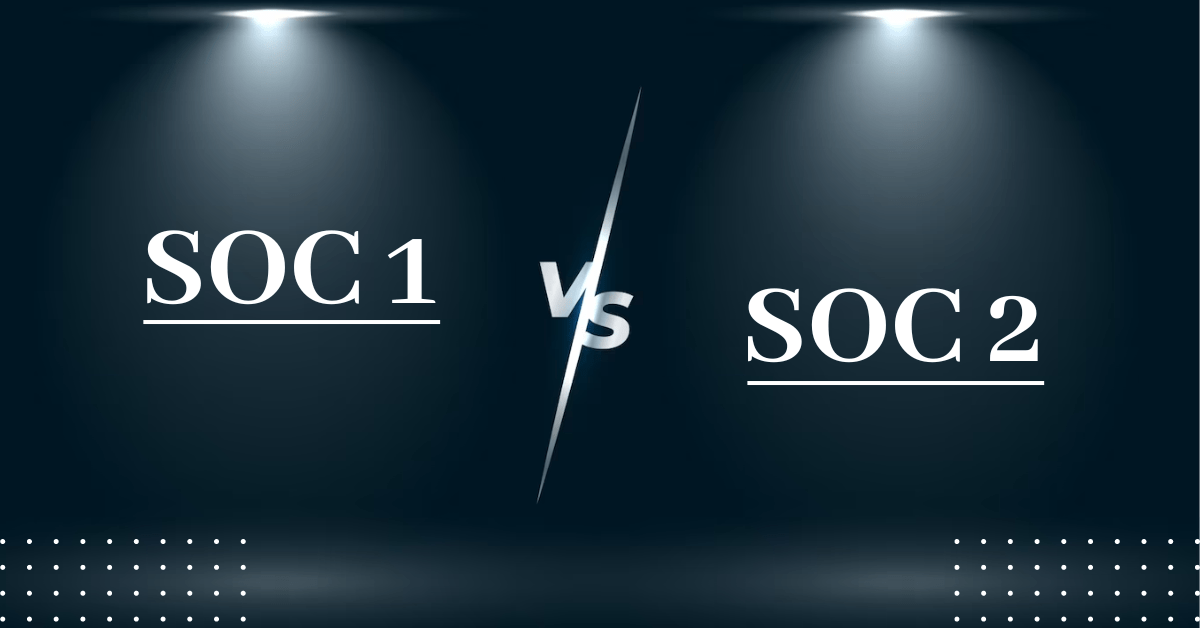
Are you confused about whether to obtain a SOC 1 or SOC 2 for your business? Our article provides a comprehensive comparison of SOC 1 vs. SOC 2, highlighting the key differences and factors to consider when choosing the right report for your needs. Make an informed decision for your business with our guide. Read now.
SOC 1 and SOC 2 are two types of audit reports that are commonly used in the business world. SOC stands for “System and Organization Controls,” and these reports are designed to evaluate the effectiveness of a company’s internal controls over financial reporting.
Understanding the differences between SOC 1 and SOC 2 is important for businesses that need to comply with regulatory requirements, meet customer expectations, or manage risks related to their internal controls.
Choosing the right type of audit report can help organizations demonstrate their commitment to security and reliability, while also helping them avoid potential legal or financial consequences.
What is SOC 1 ?
SOC 1 is a type of audit report that evaluates the internal controls of a service organization related to financial reporting.
It is also known as a Service Organization Control 1 report.
The primary purpose of SOC 1 is to assure customers and stakeholders that a service organization has effective controls in place to ensure the accuracy and completeness of financial reporting.
SOC 1 reports are often used to meet regulatory requirements, such as the Sarbanes-Oxley Act (SOX) for public companies, or to provide assurance to customers that the service organization is reliable and trustworthy.
Industries that typically require SOC 1 reports include financial services, healthcare, and technology companies that provide outsourced services.
These organizations typically process or store sensitive financial information for their clients and are required to demonstrate that they have adequate controls in place to protect this information.
There are two types of SOC 1 reports: Type 1 and Type 2.
- Type 1 report provides an opinion on the design and implementation of a service organization’s controls, while a Type 2 report evaluates the operating effectiveness of those controls over a specified period (usually six or twelve months).
- Type 2 reports are generally considered more comprehensive and provide a higher level of assurance to customers and stakeholders.
What is SOC 2 ?
SOC 2 is a type of audit report that evaluates a service organization’s internal controls related to security, availability, processing integrity, confidentiality, and privacy.
It is also known as a Service Organization Control 2 report.
The purpose of SOC 2 is to assure customers and stakeholders that a service organization has effective controls in place to ensure the security and privacy of data, as well as the availability and processing integrity of systems and information.
SOC 2 reports are often used by organizations that provide services that require the handling of sensitive or confidential information, such as cloud computing providers, healthcare organizations, and financial institutions.
Also, industries that typically require SOC 2 reports include technology, healthcare, financial services, and other industries that handle sensitive or confidential data.
These organizations are required to demonstrate to their customers and stakeholders that they have effective controls in place to protect the security and privacy of their data.
Key Differences Between SOC 1 and SOC 2
There are several key distinctions between SOC 1 & SOC 2 reports:
Focus: SOC 1 reports evaluate the effectiveness of a service organization’s internal controls over financial reporting, while SOC 2 reports evaluate the effectiveness of a service organization’s controls related to security, availability, processing integrity, confidentiality, and privacy.
Scope: SOC 1 reports only cover controls related to financial reporting, while SOC 2 reports cover a broader range of controls related to data security and privacy.
Audience: SOC 1 reports are primarily intended for customers and stakeholders who rely on the service organization for accurate financial reporting, while SOC 2 reports are intended for customers and stakeholders who are concerned about the security and privacy of their data.
Regulatory requirements: SOC 1 reports are often used to meet regulatory requirements, such as those set forth by the Sarbanes-Oxley Act (SOX), while SOC 2 reports are not specifically mandated by any regulatory bodies.
Types of reports: Both SOC 1 and SOC 2 reports have two types – Type 1 and Type 2.
However, the criteria evaluated in each report type are different.
In SOC 1, Type 1 reports evaluate the design of controls, while Type 2 reports evaluate the operating effectiveness of controls.
In SOC 2, both Type 1 and Type 2 reports evaluate the design and operating effectiveness of controls.
Type 1 reports only list the controls and processes that a company has implemented as of a specific date.
A Type 2 report with an audit period offers proof of how a company used its controls over time. A Type 2 SOC Report does not contain more severe control criteria; rather, it provides an account of how a company’s control environment performed during the audit period.
The main distinction between a Type 1 and Type 2 report’s controls is that a Type 1 report’s controls are audited or checked over time, while a Type 2 report’s testing findings are disclosed.

Which SOC Report is Right For Your Organisation?
Determining which SOC (System and Organization Controls) report is right for your organisation depends on several factors.
Both SOC 1 and SOC 2 reports are designed to assure the controls that organizations have in place to manage their services, but they differ in their focus and scope.
SOC 1 reports are focused on controls over financial reporting.
These reports are typically relevant for companies that provide services likely to impact their customers’ financial reporting, such as payroll processing, loan servicing, or investment management.
SOC 1 reports are intended to assure customers and auditors that the service provider’s controls are designed and operating effectively to meet the financial reporting needs of their clients.
SOC 2 reports, on the other hand, are focused on controls relevant to security, availability, processing integrity, confidentiality, and privacy (the five Trust Services Criteria).
These reports are typically relevant for companies that provide services that store, process, or transmit sensitive or regulated data, such as healthcare providers, financial institutions, or cloud service providers.
SOC 2 reports assure customers and stakeholders that the service provider has effective controls in place to safeguard their data and meet their security and privacy requirements.
If your organization provides services that impact your customers’ financial reporting, a SOC 1 report may be appropriate.
If your organization provides services that involve the processing, storage, or transmission of sensitive data, a SOC 2 report may be more appropriate.
Factors To Consider When Deciding Between SOC 1 and SOC 2
Business Needs: You should consider your business needs and objectives. If your business provides services that affect your clients’ financial statements, SOC 1 may be a better fit. However, if your business provides services that require the protection of confidential information, SOC 2 may be more relevant.
Customer Requirements: You should consider if your customers have specific requirements for the type of SOC report that you need to provide. Some customers may require SOC 1, while others may require SOC 2.
Industry Standards: You should consider the industry standards for your business. SOC 1 is more commonly used in industries such as finance and accounting, while SOC 2 is commonly used in industries such as technology, healthcare, and data centres.
Scope of Audit: You should consider the scope of the audit. SOC 1 reports focus on controls related to financial reporting, while SOC 2 reports focus on controls related to security, availability, processing integrity, confidentiality, and privacy.
Cost and Effort: You should consider the cost and effort involved in obtaining a SOC report. SOC 1 audits tend to be more standardized and may be less complex and time-consuming than SOC 2 audits, which require a more comprehensive evaluation of controls.
Conclusion
when deciding between SOC 1 and SOC 2 reports for your business, it’s important to carefully consider your specific needs, industry requirements, and customer expectations. SOC 1 reports are focused on controls over financial reporting and are typically relevant to businesses that offer services that have an effect on the financial accounts of their clients. On the other hand, SOC 2 reports evaluate controls related to security, availability, processing integrity, confidentiality, and privacy.
Ultimately, obtaining the right SOC report can help your business build trust, meet regulatory obligations, and address customer concerns regarding the security, reliability, and integrity of your services.



